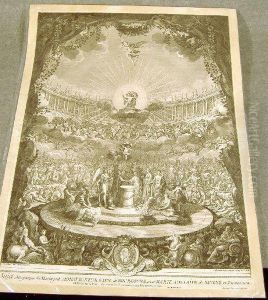Charles Louis Simonneau Paintings
Charles Louis Simonneau was a French engraver born in Orléans in 1645. He hailed from a family of artists and was the son of the lesser-known engraver, Louis Simonneau. Charles Louis received his initial training from his father before moving to Paris to further his studies under the tutelage of the distinguished engraver, Gérard Audran. Simonneau's work was highly influenced by Audran's style, which was characterized by a blend of classical elegance and the grandeur of the Baroque era.
Simonneau rapidly gained recognition for his talent in translating paintings into engravings. His ability to capture the essence of the original works while maintaining his own artistic integrity was greatly appreciated. In 1673, he was received as a member of the Royal Academy of Painting and Sculpture, a significant acknowledgment of his skill and contribution to the arts. Throughout his career, Simonneau worked on numerous projects, including the reproduction of the Galerie du Palais du Luxembourg's paintings by Rubens, which were commissioned by the Duke of Orleans.
Simonneau's engravings often depicted historical events, religious scenes, and portraits. One of his notable works includes the series of illustrations for the 'Roman History' by Charles Rollin. His engravings were not merely reproductions but also served as disseminative media for art, making the works of great painters accessible to a broader audience. Simonneau was also involved in the creation of numismatic designs and was appointed as the Graveur général des monnaies (the official engraver of the French Mint) in 1702, a prestigious position that reflected his prominence in the field.
Charles Louis Simonneau's works were characterized by meticulous detail, clear lines, and the harmonious balance of light and shadow, which was typical of the engravings of his time. His technique had a significant impact on the development of engraving in France, contributing to the refinement and popularity of the medium during the late 17th and early 18th centuries. He passed away in 1728 in Paris, leaving behind a legacy of art that continues to be studied and admired for its historical value and artistic excellence.
